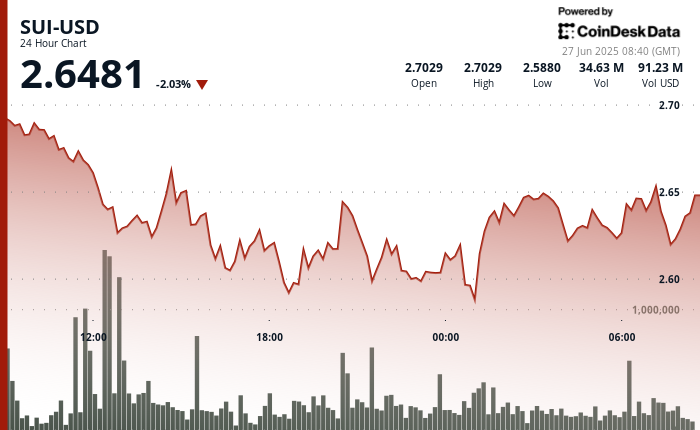Bitcoin’s
double top prospects above $100,000 warrant caution, but a full-blown 2022-style crash looks unlikely unless an unexpected black swan hits, according to digital asset banking group Sygnum’s Head of Investment Research Katalin Tischhauser.
“The crypto market is strongly sentiment-driven as fundamental valuations are challenging; therefore, technical analysis signals such as the double top warrant caution. That said, a full-blown crash needs a catalyst like the Terra collapse of 2022 or the FTX blowup. Barring a similar black swan, we could see a prolonged bull cycle, based on the current political and regulatory support and sticky institutional capital flowing in,” Tischhauser told CoinDesk in an interview.
Bitcoin has spent 50 days mainly trading back and forth between $110,000 and $100,000, signaling an exhaustion of the uptrend near the highs reached in January this year. That has prompted several observers, including veteran technical analyst Peter Brandt, to consider the possibility of the BTC trend flipping bearish with a double-top pattern.
The double top comprises two consecutive peaks at approximately the same price – near $110K in BTC’s case – with a trendline drawn through the low point between these peaks. The low point in BTC’s case is the early April slide to $75,000. Analysts are concerned that a potential double top breakdown, involving a downturn from $110,000 and a drop below $75,000, could lead to a crash to around $27,000. Yes, you read that right. Such a crash would mean a 75% slide from the peaks.
Technical patterns, such as the double top, often become self-fulfilling prophecies – once traders spot the pattern, their collective action reinforces the expected outcome. So, it’s natural for prospects of double top above $100,000 to cause some caution and price drop.
However, technicals alone seldom cause a price crash of 75%. For instance, BTC’s crash from $70,000 to $16,000 over the 12 months to November 2022 happened as the Fed’s rate hike cycle exposed asset classes like crypto where excess speculation had built up, setting the stage for the demise of the Terra blockchain and the FTX exchange. Both events caused massive wealth destruction.
Flows-led bull run
The latest rally, however, is driven mainly by institutional flows rather than the story or pretence that DeFi is better than traditional finance or Ethereum is the new world computer, as Bloomberg’s Joe Weisenthal noted last year.
Since their debut on the Nasdaq in January 2024, the 11 spot bitcoin exchange-traded funds (ETFs) have registered net inflows of over $48 billion, per data tracked by Farside Investors. Meanwhile, BTC’s adoption as a corporate Treasury asset has picked up the pace, adding to the bull momentum. As of the time of writing, 141 public companies held 841,693 BTC, according to bitcointreasuries.net.
The flows-driven nature of the latest bull run makes it more resilient than the previous bull markets, according to Tischhauser.
“Institutions implement rigorous due diligence and risk assessment before they add a new asset class like bitcoin to the model portfolio. But when they do, the eventual allocation is for the long term. This trend of sticky institutional allocation is just beginning, and the resulting demand will continue to provide price support for some time to come,” Tischhauser told CoinDesk.
Tischhauser explained that these investment vehicles are sucking out liquidity, skewing the demand-supply dynamics in favour of a continued uptrend.
“These investment vehicles are sucking liquidity out of the market, which means, every time a new big-ticket investor hits the market with bids, this is addressing less and less supply, and the bullish impact on prices becomes more pronounced,” Tischhauser noted.
The halving cycle may be dead
The bearish double-top crash scenario appears plausible to many observers, as we are in the post-halving year, which has historically marked bull market tops, paving the way for year-long bear markets.
Halving is a programmed code in Bitcoin’s blockchain that reduces the pace of BTC supply expansion by 50% every four years. The last halving occurred in April 2024 and reduced the per-block BTC reward to 3.125 BTC from 6.25 BTC.
However, the halving cycle may not unfold as expected, as sticky institutional adoption has a greater bearing on price than miners. Moreover, BTC sold by miners, who regulatory offload coins earned to fund operational costs, now accounts for a tiny percentage of the average daily trading volume.
“The change in market leadership means the four-year halving cycle may not play out religiously as it did before. Earlier, most BTC holders were miners, and the BTC issued per year was a huge percentage of the outstanding bitcoin supply. So, selling pressure from miners mattered greatly to the market price. Now, the BTC mined is 0.05-0.1% of the average BTC daily trading volume and halving this supply has no impact on the supply/demand balance in the market. So the halving cycle may be dead,” Tischhauser said.




